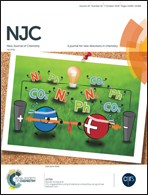Cd(ii) and Cu(ii) coordination polymers constructed from the expanded 1,4-bis(4-pyridyl)-2,3-diaza-1,3-butadiene ligand: conventional and ultrasound-assisted synthesis, crystal structure, luminescence and magnetic properties†
Abstract
A 3D open inorganic/organic framework, {[Cd(μ-L)(μ3-SO4)(H2O)]·H2O}n (1) [L = 1,4-bis(4-pyridyl)-2,3-diaza-1,3-butadiene] was synthesized by the reaction of CdSO4·8H2O with L. The treatment of Cu(NO3)2·3H2O with the same N,N′-donor ligand in two different solvent mixtures, methanol/dichloromethane (2) and methanol/chloroform (3), afforded two new ladder-like coordination polymers of formula {[Cu(μ-L)(μ-NO3)(NO3)]·solv}n [solv = CH2Cl2 (2) and CHCl3 (3)]. The non-interpenetrated ladder motifs 2 and 3 enclathrate the uncoordinated solvent molecules. Crystalline coordination polymers 1 and 3 were also successfully prepared by a sonochemical method under different reaction conditions. Our results indicate that the size of the particles is dependent on the irradiation time. 1 and 3 exhibit intense luminescent emissions in the solid state at room temperature. Cryomagnetic measurements of 3 show the occurrence of a ferromagnetic interaction between the copper(II) ions through the double oxo-nitrate bridge together with a very weak inter-ladder antiferromagnetic interaction [J = +4.93(2) cm−1, g = 2.10(1) and Θ = −0.567(5) K].



 Please wait while we load your content...
Please wait while we load your content...